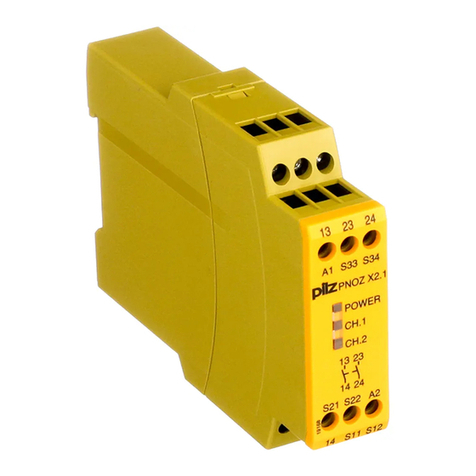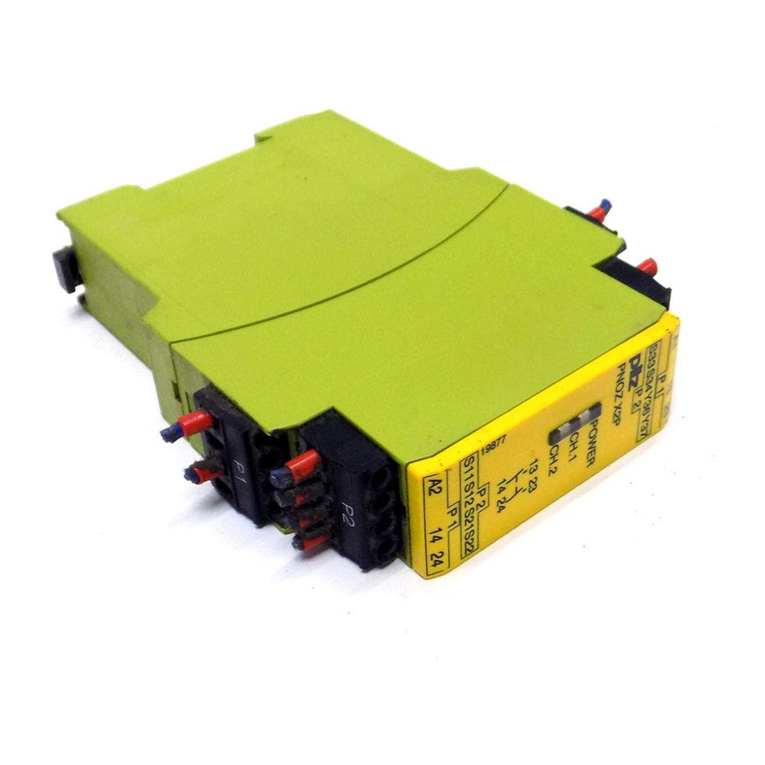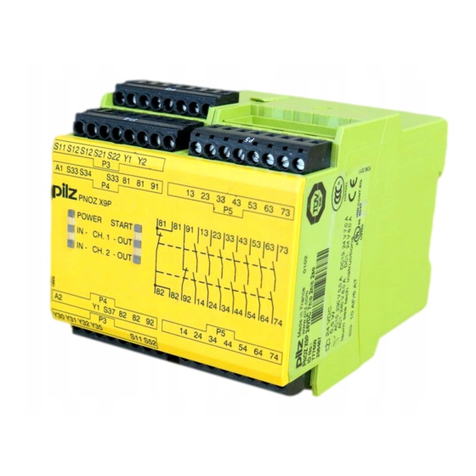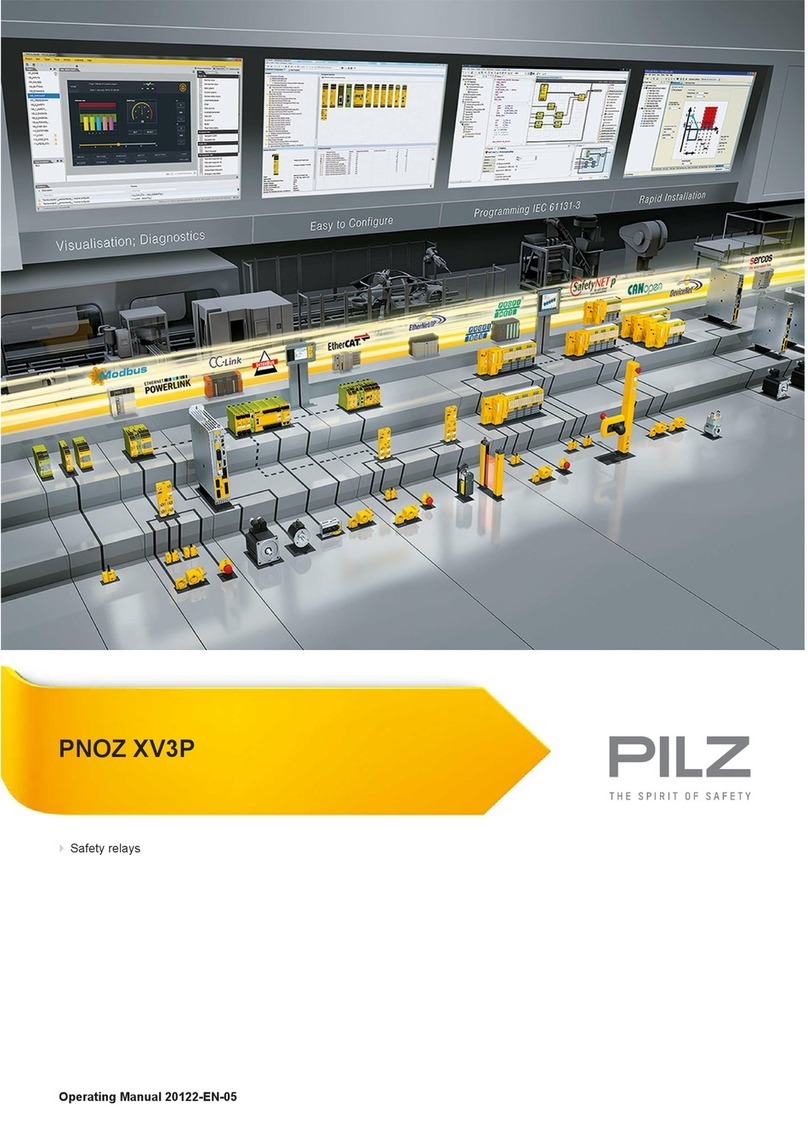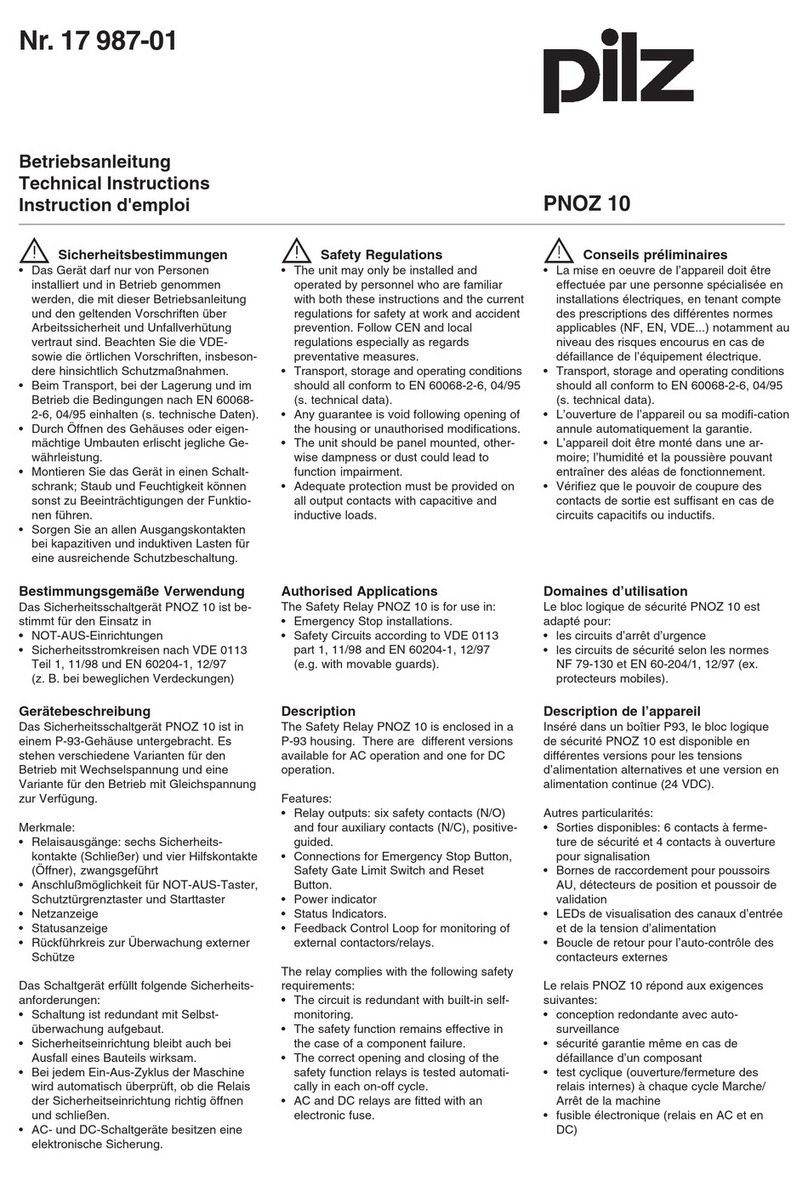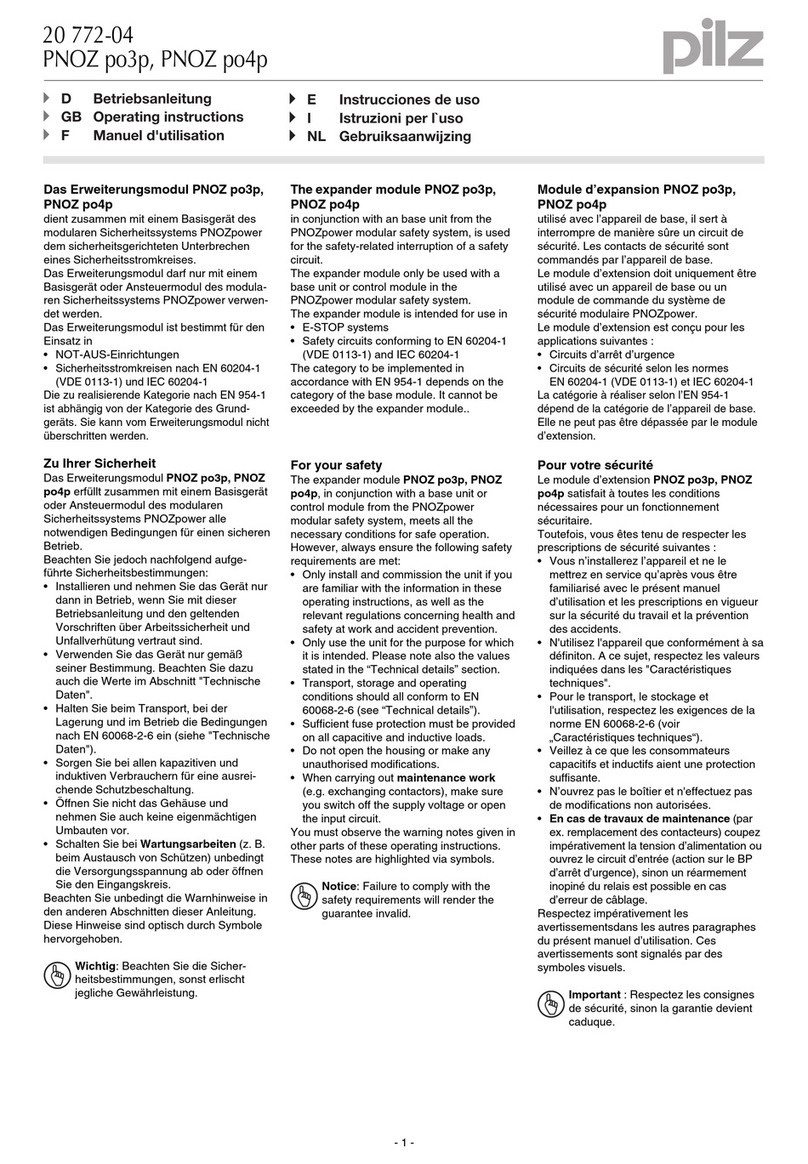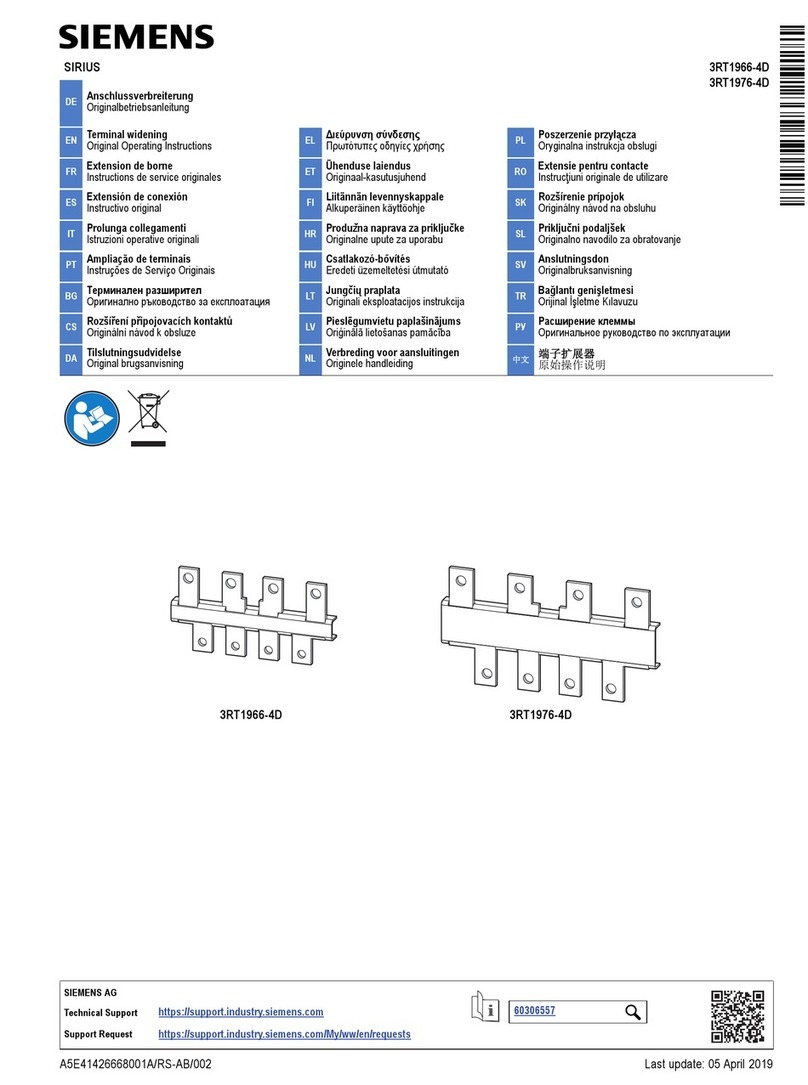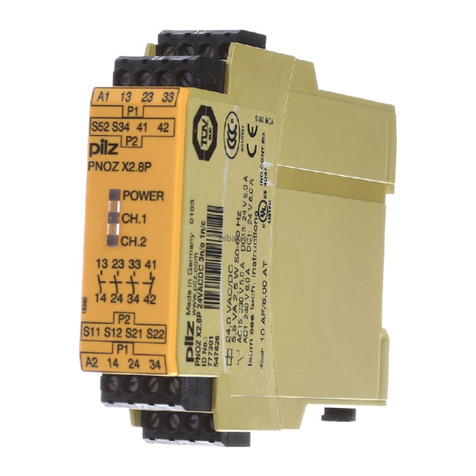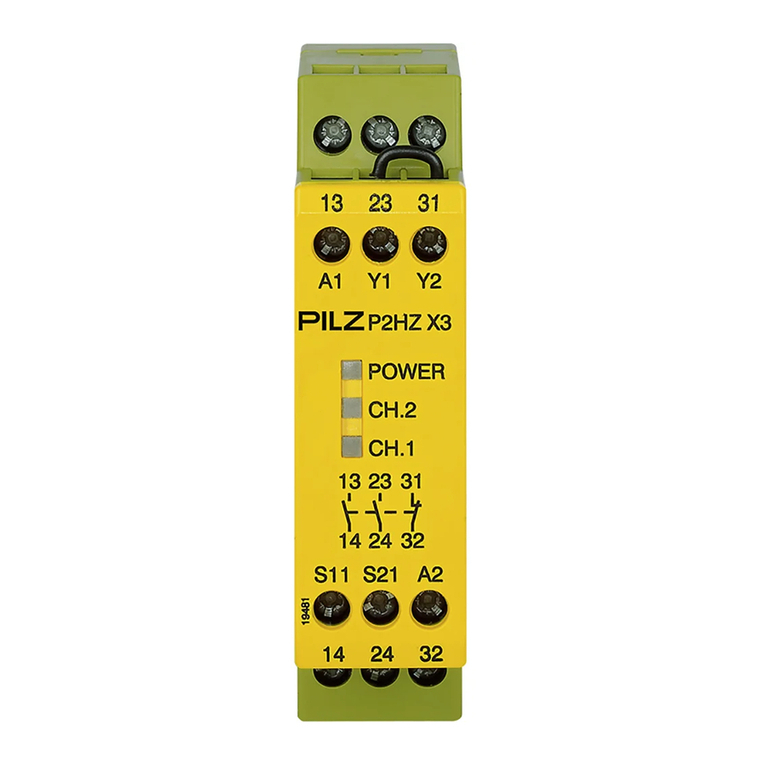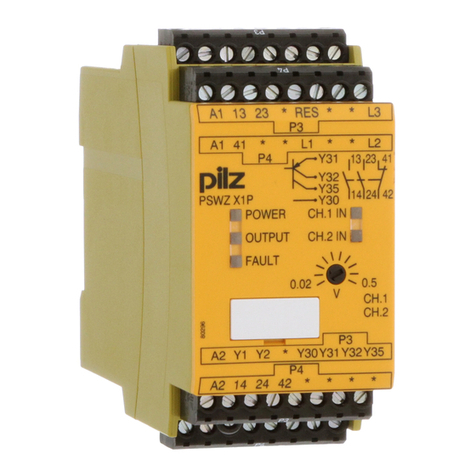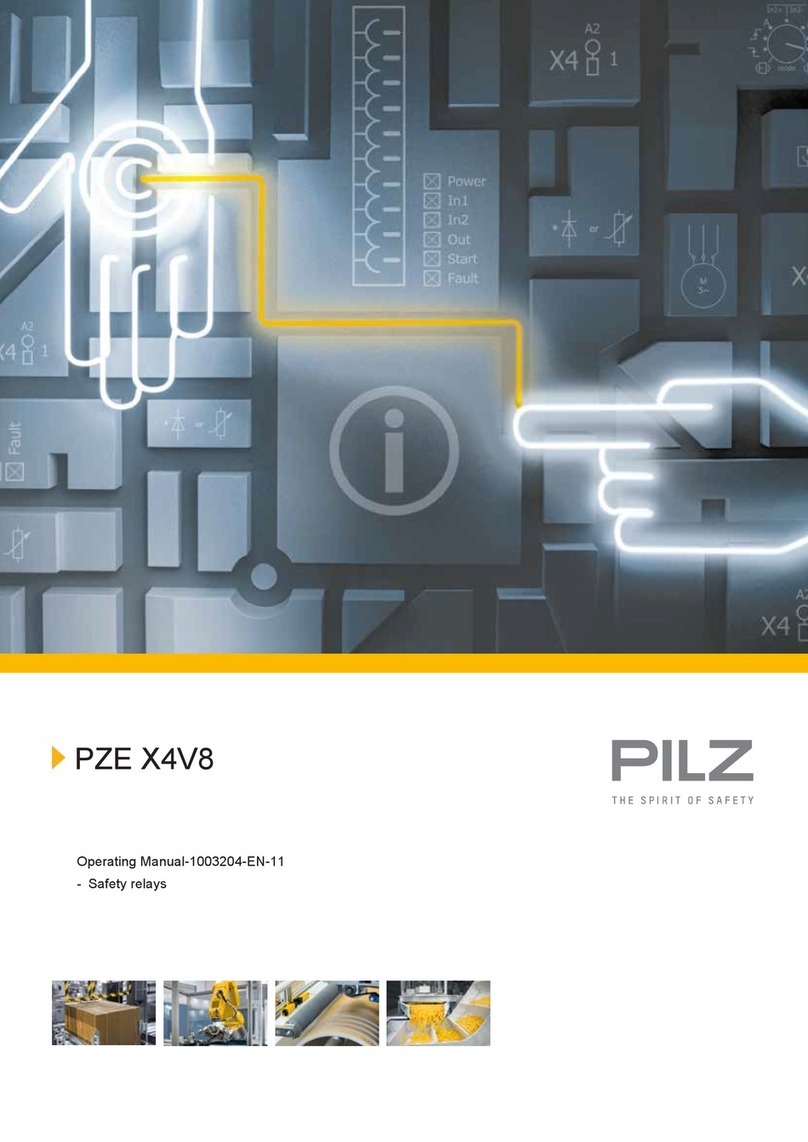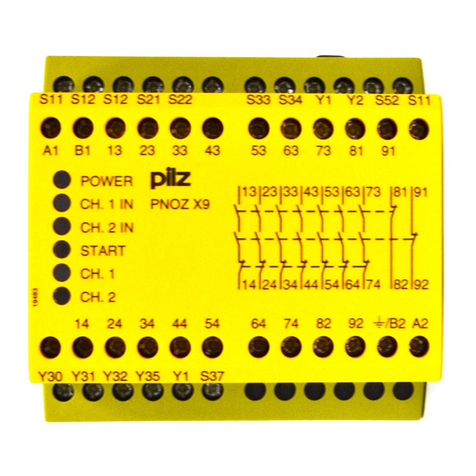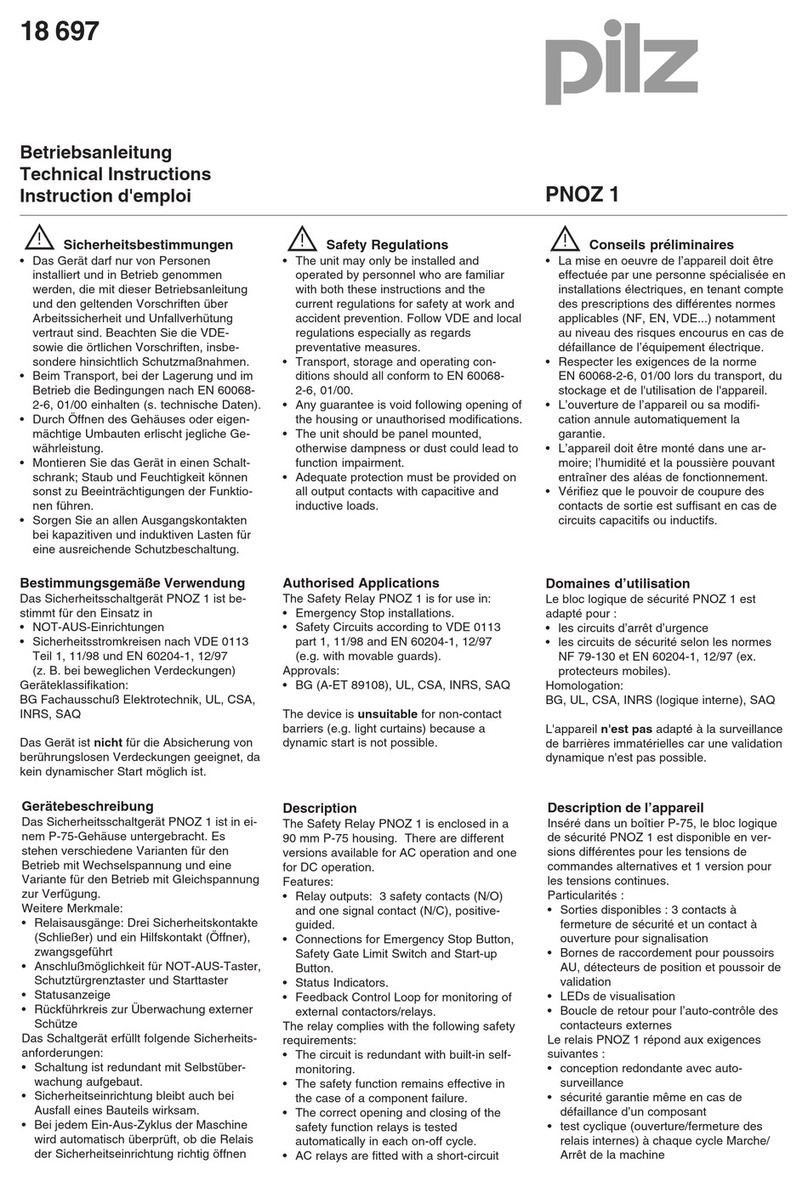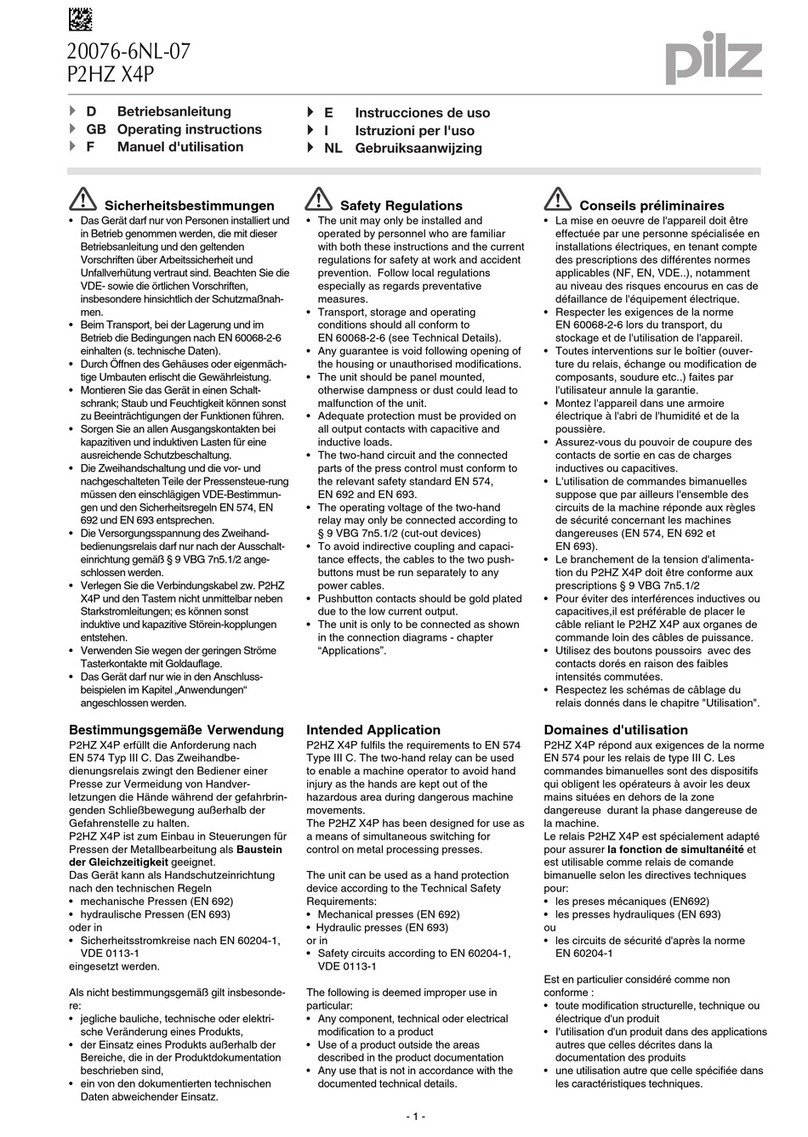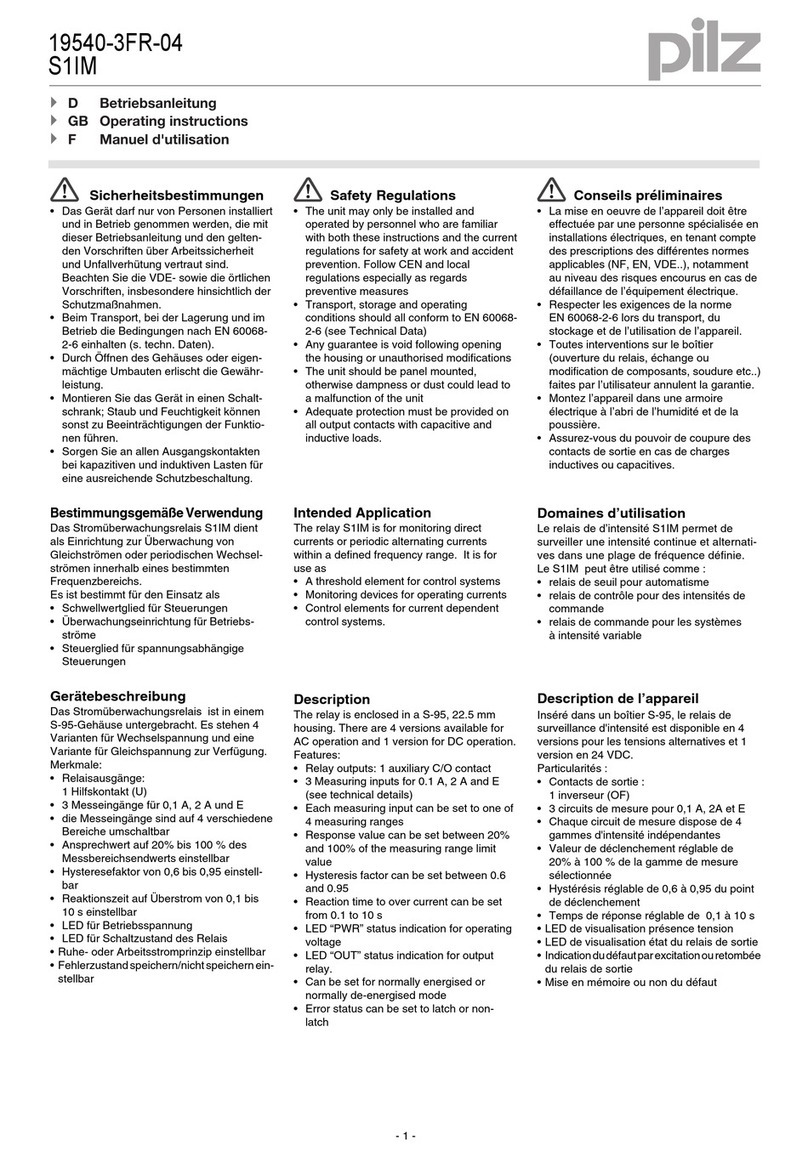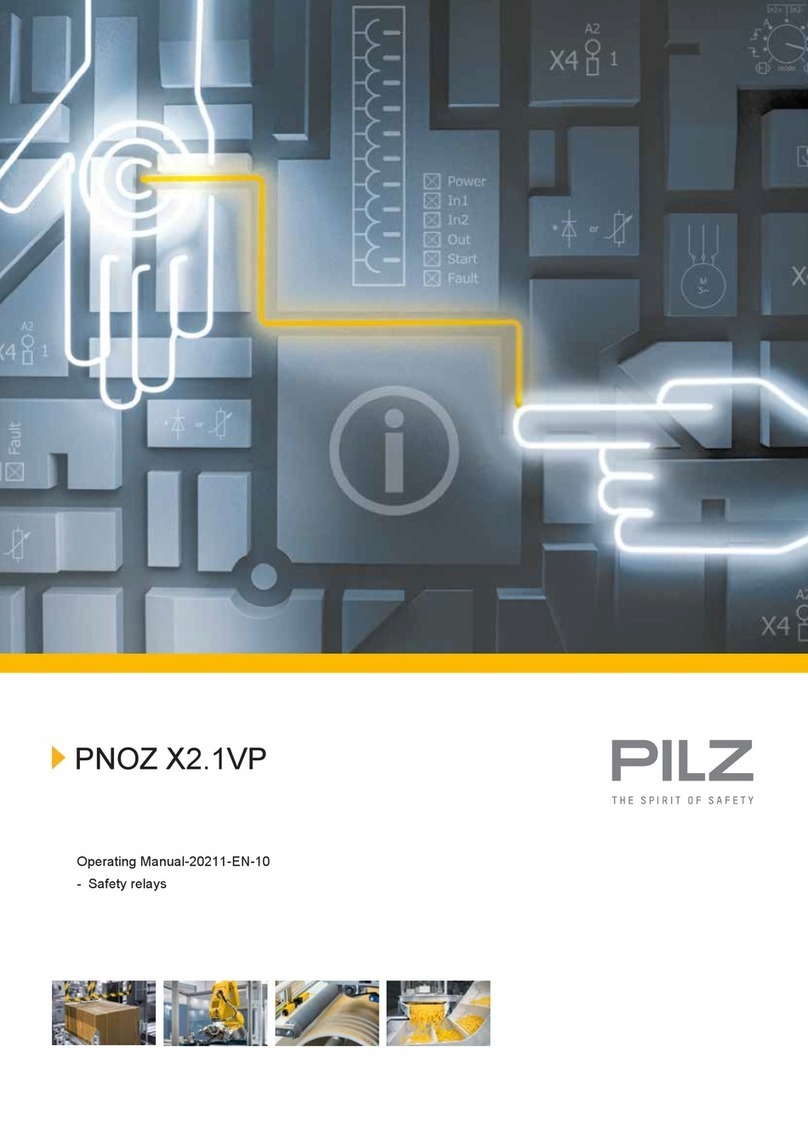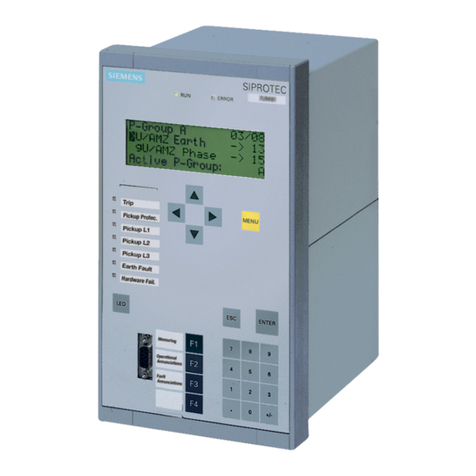
- 2 -
Gerätebeschreibung
Sicherheitseigenschaften
Das Schaltgerät erfüllt folgende Sicher-
heitsanforderungen:
• Die Schaltung ist redundant mit Selbst-
überwachung aufgebaut.
• Die Sicherheitseinrichtung bleibt auch bei
Ausfall eines Bauteils wirksam.
• Die Sicherheitsausgänge werden durch
einen Abschalttest periodisch geprüft.
• Das Gerät besitzt eine elektronische
Sicherung.
Gerätemerkmale
• Ausgänge in Halbleitertechnik:
2 Sicherheitsausgänge, 1 Hilfsausgang
und 2 Taktausgänge
• Anschlussmöglichkeit für
Sicherheitsensoren PSEN 2.1p-10 und
PSEN 2.1p-11 oder Positionsschalter mit
Öffner-/Schließer-Kombination
• Hilfsausgang umschaltbar als Diagnose-
ausgang
• UND- und ODER-Eingang zur logischen
Verknüpfung mehrerer Geräte
• Querschlussüberwachung durch Takt-
ausgänge
• Statusanzeige
• Rückführkreis zur Überwachung externer
Schütze
Description
Safety features
The safety relay fulfils the following safety
requirements:
• The circuit is redundant with built-in self-
monitoring.
• The safety function remains effective in the
case of a component failure.
• The safety outputs are tested periodically
using a disconnection test.
• The unit has an electronic fuse.
Unit features
• Outputs use semiconductor technology:
2 safety outputs, 1 auxiliary output and
2 test pulse outputs
• Connection for safety switches
PSEN 2.1p-10 and PSEN 2.1p-11 or
position switches with combination of N/C
and N/O
• Auxiliary output can be used as a
diagnostic output
• AND/OR input for logic links between
several units
• Test pulse outputs monitor shorts across
the input contacts
• Status display
• Feedback loop for monitoring external
contactors
Description de l’appareil
Propriétés de sécurité
Le bloc logique de sécurité satisfait aux
exigences de sécurité suivantes :
• Conception redondante avec auto-
surveillance.
• Fonction de sécurité garantie même en
cas de défaillance d'un composant interne
• Les sortie de sécurité sont testées
périodiquement à l'aide d'un test de
coupure.
• L'appareil est équipé d'un fusible
électronique.
Caractéristiques de l’appareil
• Sorties statiques :
2 sorties de sécurité, 1 sortie d'information
et 2 sorties impulsionnelles
• Raccordement possible des capteurs de
sécurité PSEN 2.1p-10 et PSEN 2.1p-11
ou d’un interrupteur de position avec un
contact à ouverture et un contact à
fermeture
• Temporisation à la retombée réglable
• Sortie d'information commutable en sortie
de diagnostic
• Entrées ET et OU pour le couplage
logique de plusieurs appareils
• Surveillance des courts-circuits par sorties
impulsionnelles
• Affichage de l’état
• Boucle de retour pour le contrôle des
contacteurs externes
Descriptif du fonctionnement
Fonctionnement
Deux micro-processeurs analysent les
circuits d'entrée et pilotent en conséquence
les sorties. Les micro-processseurs se
contrôlent mutuellement.
Etat des sorties
• Circuit d’entrée fermé (par exemple le
poussoir d’AU n’a pas été activé)
Mise sous tension des sorties de sécurité
14 et 24 et de la sortie d'information Y32.
• Circuit d’entrée ouvert (par exemple le
poussoir d’AU a été activé).
Blocage des sorties de sécurité 14 et 24 et
de la sortie d'information Y32.
Fonctions
• Si un signal Haut (+24 V CC) est appliqué
sur l’entrée Y5 pendant au moins 250 ms,
la sortie Y32 commute en sortie
diagnostic. Son exploitation est réalisée
via un protocole disponible en tant
qu'accessoire ou développé par
l'utilisateur. Si l’entrée Y5 est ouverte ou
Bas, Y32 fonctionne comme une sortie
d'information.
• Pour le couplage logique de plusieurs
appareils, le PNOZ e3.1p possède une
entrée ET et une entrée OU. Les entrées
ont une temporisation de couplage qui est
cumulative dans le cas d’une liaison ET.
Modes de fonctionnement
• Commande par 2 canaux : Les mises à la
terre dans le circuit d’entrée et les courts-
circuits entre les canaux d’entrée sont
détectés.
• Réarmement automatique :L’appareil
est actif dès que le circuit d’entrée est
fermé.
• Réarmement auto-contrôlé :L’appareil
n’est activé qu’après avoir appuyé sur le
poussoir de réarmement et après avoir
relâché le bouton. De ce fait un réarme-
ment automatique ou un pontage du
Function
Operation
Two microcontrollers evaluate the input
circuits and switch the outputs accordingly.
The microcontrollers monitor each other.
Output status
• Input circuit: N/C open and N/O closed
(e.g. safety gate closed).
Safety outputs 14 and 24 and auxiliary
output Y32 are energised.
• Input circuit: N/C is closed and N/O is
opened (e.g. safety gate open).
Safety outputs 14 and 24 and auxiliary
output Y32 are de-energised.
Functions
• If there is a high signal (+24 VDC) at input
Y5 for at least 250 ms, output Y32
switches to diagnostic mode. It is
controlled via a driver that is available as
an accessory or that you can create
yourself. If input Y5 is open or low, Y32 will
operate as an auxiliary output.
• For logic links between several units, the
PNOZ e3.1p has one AND and one OR
input. The inputs have a time delay,
which is added in the case of an AND
connection.
Operating modes
• Dual-channel operation: Earth faults in
the input circuit and shorts between the
input circuit contacts will be detected.
• Automatic reset: unit becomes active as
soon as the input circuit is closed.
• Monitored reset: unit is active when the
reset button is pressed and then released.
This prevents an automatic reset and
linking of the reset button.
• Shorts between contacts can be
detected by pulsing the input circuits. This
operating mode is detected automatically
on start-up.
Funktionsbeschreibung
Arbeitsweise
Zwei Mikro-Controller werten die Eingangs-
kreise aus und schalten abhängig davon die
Ausgänge. Die Mikro-Controller überwachen
sich gegenseitig.
Zustand der Ausgänge
• Eingangskreis: Öffner geöffnet und
Schließer geschlossen (z. B. Schutztür
geschlossen).
Die Sicherheitsausgänge 14 und 24 und
der Hilfsausgang Y32 leiten.
• Eingangskreis: Öffner wird geschlossen
und Schließer geöffnet (z. B. Schutztür
geöffnet).
Die Sicherheitsausgänge 14 und 24 und
der Hilfsausgang Y32 sind gesperrt.
Funktionen
• Wird an den Eingang Y5 für mindestens
250 ms ein High-Signal (+24 V DC) gelegt,
wechselt der Ausgang Y32 in die
Diagnosefunktion. Die Ansteuerung
erfolgt über einen Treiber, der als Zubehör
zur Verfügung steht oder selbst erstellt
werden kann. Ist der Eingang Y5 offen
oder Low, funktioniert Y32 wie ein
Hilfsausgang.
• Zur logischen Verknüpfung mehrerer
Geräte besitzt das PNOZ e3.1p einen
UND- und einen ODER-Eingang. Die
Eingänge weisen Schaltverzögerungen
auf, die sich im Falle einer UND-Ver-
knüpfung addieren.
Betriebsarten
• Zweikanaliger Betrieb: Erdschlüsse im
Eingangskreis und Querschlüsse zwischen
den Eingangskreiskontakten werden
erkannt.
• Automatischer Start: Gerät ist aktiv,
sobald der Eingangskreis geschlossen ist.
